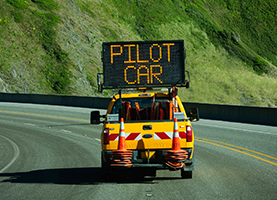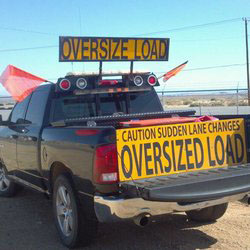Pilot Cars: Emergency Lights for Escort Vehicles
Posted by Extreme Tactical Dynamics on Jun 29th 2019
So you want to drive a pilot car, huh? Do you know what it takes? If you’re thinking about becoming a qualified pilot escort, there are a number of things you need to be aware of. Do you know the licensing requirements vary from state to state? Do you know what other lighting and equipment is required in you state?
 What is a Pilot Car?
What is a Pilot Car?
A pilot car travels in front of or behind a tractor trailer carrying a wide-load and is equipped with a caution light bar. These vehicles are sometimes referred to as flag or escort cars and are a specialized service. Pilot car drivers are pros that understand safety concerns of getting a wide load tractor-trailer to a particular destination.
Pilot Car General Safety Requirements
A professional escort driver must own or operate a reliable vehicle with no mechanical malfunctions. However, your family sedan probably won’t make the cut. Most pilot cars have basic safety equipment including amber warning lights, emergency light bars, flags, telescopic poles, CB radios and emergency equipment that must be installed and carried in the vehicle. So, unless you plan on embarrassing your kids in the parent pick-up line, your pilot car won’t be an everyday driver. If an escort driver is pulled over by law enforcement, they may be fined or cited for not having the appropriate equipment required by their state.
What Training Does a Driver Need?
Some states require a driver to have a permit to escort a wide load. It’s important to note not just anyone can obtain this type of permit. Permits in most states need the driver of an escort vehicle to be certified and trained by a specialized driving school. Some states don’t require a pilot car driver to be certified but have other requirements instead.
The states that do require certifications for these vehicles have strict requirements about equipment and training. States that require certification include Arizona, Kansas, Virginia, Washington, and New York. To be certified, a driver must pass an approved training course, pass a test, and prove they have and understand needed safety equipment. Pennsylvania law requires pilot car drivers to carry specialized insurance coverage. States that don’t need certifications for drivers may still need a permit for a driver to escort a wide or heavy load through an area.
Who can apply to Pilot Escort School?
Pilot driving schools exist all over the world. To qualify to attend pilot car training, a driver must be at least 18 years old. At a certified training school, drivers will be introduced to the pilot car manual for the state and learn about applicable statue rules. After the training course, drivers will have to take a specialized driving test. Training classes and tests are essential to safety because drivers rely on the training they receive in school, their emergency equipment, and warning lights to keep them safe on the road.
How common are Pilot Car Services?
Pilot car services are used and operate all over the United States. Drivers can opt to be employed through a company or organization or work for themselves. Individuals who work for themselves will have to pay their liability insurance, which can be quite expensive. Private escorts are also responsible for maintaining their vehicle and making sure all warning lights and equipment are in good working order.
Some companies have standardized fleets and more liberal companies offer lights and equipment that can be transferred from one vehicle to another. Businesses can also get comprehensive vehicle insurance for fleet vehicles at a lower cost, and usually, hire a person to maintain the vehicle on a regular basis.
How are Pilot Car Escorts Paid?
If you’ve decided you may want to be a pilot car escort, you’re probably interested in how this occupation pays. It’s true that escorting heavy haulers can be a lucrative career, but there’s several factors that need to be considered. If you’re a freelance escort, you’re going to be responsible for the maintenance to your vehicle, gas, emergency lights, and other safety equipment. These costs can add up fast, but are worth it if you can drive quickly and safely. It’s possible to reduce some of the costs associated with the career by buying equipment from reputable dealers.
If you work for a fleet company, you may get paid by the trip or may have other salary arrangements. When deciding whether to go freelance or work for a fleet company, it’s important to look at all the pros and cons. Will the fleet company provide a vehicle? Do you have to use your own? Will you be required to buy warning lights and safety equipment, or will it be provided. Not all fleet companies offer the same compensation plans and freelancing can be expensive for a newbie.
 How Do Wide Loads Avoid Each Other on the Roads?
How Do Wide Loads Avoid Each Other on the Roads?
Imagine two wide loads meet each other on a narrow, deserted road. Since neither can pass, one would have to back up, and chaos would ensure. With this in mind, there has to be a way to keep other drivers informed of scheduled routes. Live Map is a lifesaver in this situation because it allows escort drivers to share their planned route with other drivers and offers solutions to traffic jams and detours.
The Live Map is always updating due to user input and satellites. With up to date alerts and information, a pilot car driver can trust the Live Map to keep them on track.
The importance of pilot cars in maintaining safety on the road is often overlooked. These warning vehicles are responsible for the driver, tractor-trailer, and load on the tractor. With the drivers experience, safety equipment, and warning lights, a driver may not notice a heavy hauler on the road, which could lead to safety concerns such as collisions and roll-overs. When outfitted with an experienced driver and amber warning lights, amber light bar, and safety equipment, a pilot car will be most efficient and maintain the safety of their travels.
Related Posts
- Mini Light Bars are Perfect for Construction Company Vehicles
- The Benefits of Strobe Lights on Construction Vehicles
- What are the Best Emergency LED Strobe Lights for My Motorcycle
- Popular LED Warning Lights for Tractors
- Tow Truck Lighting Requirements
- Extreme Tactical Dynamics Goes to Hollywood
 Facebook
Twitter
Google+
Instagram
YouTube
Facebook
Twitter
Google+
Instagram
YouTube

